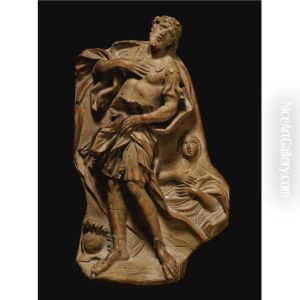Melchiore Caffa Il Maltese Paintings
Melchiore Caffa, known as Il Maltese due to his Maltese origins, was a Baroque sculptor whose work played a significant role in the Roman art scene of the 17th century. Born in 1636 in Birgu, Malta, Caffa showed early artistic promise and was sent to Rome to further his education and career. In Rome, he became a protégé of the well-established sculptor Ercole Ferrata, who was a student of the renowned artist Gian Lorenzo Bernini. Under Ferrata's guidance, Caffa honed his skills and began to adopt the dynamic and emotive style characteristic of the High Baroque period.
Caffa's sculptures are noted for their dramatic use of space and light, as well as the intense emotional expression of the figures he carved. His works often incorporated the twisted figures and flowing drapery that were hallmarks of the Baroque style. He became particularly well-known for his religious sculptures, including altarpieces, statues, and funerary monuments. His ability to convey deep spirituality and pathos made his works highly sought after by churches and private patrons alike.
One of Caffa's most famous works is the 'Transverberation of Saint Teresa,' which shows the saint in a moment of divine ecstasy. The sculpture was originally intended for the church of San Francesco a Ripa in Rome, but it was never placed there due to Caffa's untimely death. Instead, it was installed in the church of Santa Maria della Vittoria, where it remains one of the most visited sculptural works in Rome.
Tragically, Caffa's career was cut short when he died in 1667 at the age of 31. Despite his brief career, his impact on Baroque sculpture was profound, and his works continue to be studied and admired for their emotional power and technical mastery. Caffa's contributions to the arts are remembered as some of the most important of the Baroque era, and his sculptures remain a testament to his remarkable talent.
